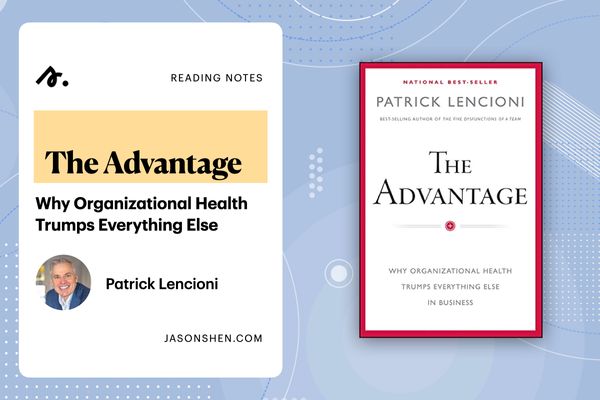I recently finished reading The Advantage: Why Organizational Health Trumps Everything Else in business by Patrick Lencioni. You’ve definitely heard Lencioni’s other books: Death by Meeting and The Five Dysfunctions of a Team were two which popularized the trend in the late aughts of the business book as a fable.
This book is more of a typical nonfiction business book: a main idea broken into several components with tactics combined with stories and case studies from consulting engagement it’s plus personal anecdotes all rolled into one concise and clearly written book.
In a nutshell:
The book’s thesis is that companies that are most successful focus on being healthy over being smart. Lencioni argues there’s been an overemphasis on things like strategy, marketing, technology and other “sophisticated” business elements.
Instead he says we should focus on healthy companies, which are characterized by having minimal politics, minimal confusion, high morale and high productivity. Lencioni says these healthy companies tend to beat the companies that are focused on just being “smart”.
In order to create a healthy company you need to first build out cohesive leadership team, then create clarity within the team, then communicate that clarity to the organization, and finally reinforce that clarity constantly.
Key Takeaways
Trust is number one
The first step to building a cohesive leadership team is building trust within the individual team members. Specifically building what Leoncini calls “vulnerability – based trust”. As he put it:
“When everyone on a team knows that everyone else is vulnerable enough to say and mean those things, and that no one is going to hide his or her weaknesses or mistakes, they develop a deeper an uncommon sense of trust.”
He encourages having team members talk about their personal histories, doing profiling through something like Myers-Briggs, and avoiding the fundamental attribution error.
Conflict is important
Once a leadership team is built the level of trust with each other, it’s important for them to be able to disagree openly about issues. Lencioni believes it is dangerous to work in a false sense of harmony because it leads to frustration, resentment, and bad decision making. He even encourages leaders to “mine for conflict” in meetings.
“By looking for and exposing potential and even subtle disagreements that have not come to the surface, team members – and heck team members can do it too – avoid the destructive hallway conversations that inevitably result when people are reluctant to engage in direct, productive debate.”
This is one forced me to reconsider my approach to conflict since I’m often one to try to smooth disagreements over rather than deal with overt conflict.
The team effectiveness exercise
One of the ways teams can build more accountability into their dynamic is through something that the author calls “team effectiveness exercise”. This is usually done at the end of a two day offsite meeting only if the team has really built a good level of trust.
The exercise works by having everyone write down one key strength or contribution to the team and one weakness or negative behavior for the team for every individual on the team. Then, starting with the leader, they have every person in the group share the positive contribution and then the negative behavior. When done well, this brings immediate benefits from the feedback itself, but “the greatest impact is the realization on the part of leadership team members that holding one another accountable is a survival and productive activity”
First team
Lencioni’s company appears to work a lot with big organizations where the leadership may not even work in the same country, much less the same building or floor. When executive leaders don’t work closely together, they can start to feel more loyalty and responsibility to their respective departments than the leadership team they are a part of.
As Lencioni’s puts it, “this is absolutely natural, common, and understandable. And dangerous.”
He believes it’s critical, and far better for both the organization and its employees for executives to see the leadership team as their first priority, with their individual departments coming in second.
The Six Clarifying Questions
In order to create clarity for the organization, leaders must be able to align on the answers to six questions. I thought this was a really simple and powerful way to cut through to the essence of any organization.
- Why do we exist? (Higher purpose)
- How do we behave? (Values)
- What do we do? (Very straightforward definition of the market / industry)
- How will we succeed? (The strategic anchors that give this org an advantage)
- What is most important, right now? (The current thematic goal / rallying cry)
- Who must do what? (Dividing up responsibilities)
How to make meetings work
After clarity is created, it must be communicated and reinforced again and again. Part of how that inevitably happens is brought meetings. While people complain a lot about meetings, I believe they both serve as forcing functions for accomplishing work and if run efficiently, can be much better than email or chat for moving projects forward. Lencioni describes the 4 basic types of meetings:
- Daily Check In – we do stand ups at Etsy for our product squads and he recommends them too (5-10 mins)
- Weekly Staff Meeting – real-time agendas allow the most important issues, as measured against the current Thematic goal, to discussed and resolved (45-90mins)
- Ad hoc Tactical – these are the meetings where bigger, strategic issues like major problems or opportunities get hashed out. (2-4 hrs)
- Quarterly Off-Site – this is reviewing strategic anchors, thematic goals, reviewing progress against milestones, and retrospective looks at past work (1-2 days)
There’s so much more in The Advantage, including both tactical suggestions and memorable anecdotes from Lencioni’s client work and I highly recommend any leader or aspiring leader check it out.

